2013 MacBook Air: PCIe SSD and Haswell ULT Inside
by Anand Lal Shimpi on June 10, 2013 10:01 PM EST- Posted in
- Mac
- Storage
- SSDs
- Apple
- MacBook Air
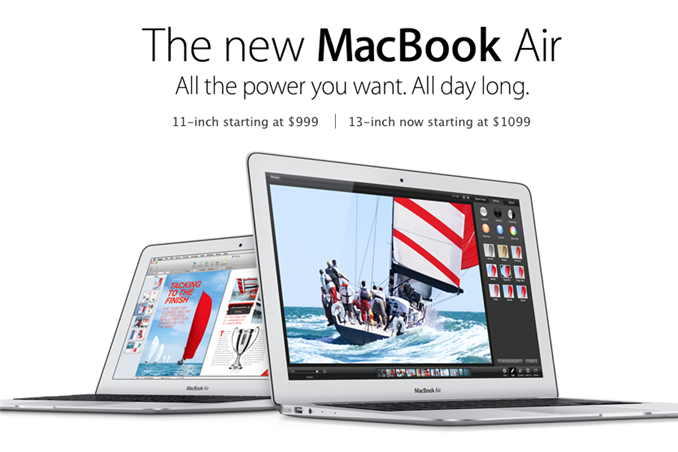
This morning Apple updated its MacBook Air to Intel's Haswell ULT silicon. The chassis itself didn't get any updates, nor did the displays. Both the 11 and 13 inch models retain their non-Retina 1366 x 768 and 1440 x 900 displays. There's a slight increase in battery capacity. The 11-inch model moves to 38Wh (8.6%) while the 13-inch model goes to 54.4Wh (8.8%). The big changes however are on the CPU, NAND and DRAM fronts.
With the new MacBook Air, Apple moves to a Core i5-4250U. The base clock drops to 1.3GHz across all of the models, but max turbo remains at 2.6GHz. Although the base clock is lower, I wouldn't expect substantially lower performance since the max turbo is unchanged as is the chassis that has to dissipate the thermals. To confirm, I ran a couple of Cinebench tests and generally found performance similar to that of last year's models:
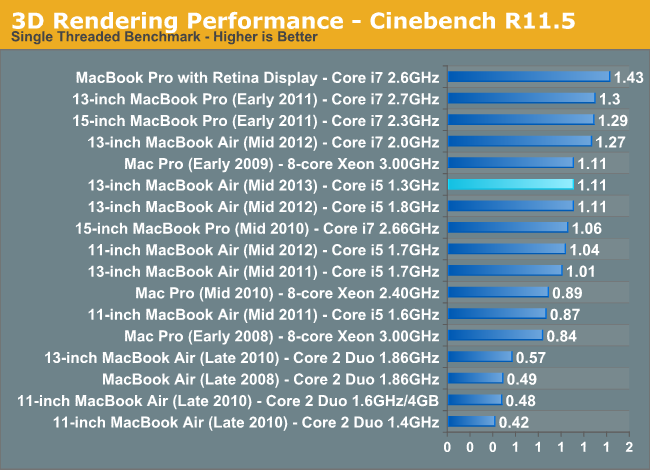
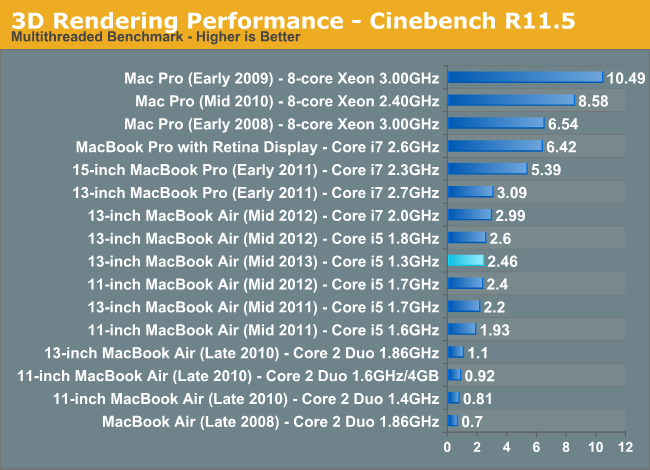
The 1.8GHz i5 in the 13-inch ended up being a bit quicker than the 1.3GHz 4250U this generation in the multithreaded test, but in single threaded performance the two are equal. The impact on the MT test is about 5%, it's there but not substantial. Don't be fooled by base clock, it's the combination of base clock, max turbo and cooling solution that'll determine performance here. As we found in our Haswell ULT review, CPU performance isn't something you can expect to see more of with Haswell vs. Ivy Bridge in these low wattage platforms.
You can get a 1.7GHz Core i7 upgrade with a 3.3GHz max turbo (i7-4650U). Both parts have Intel GT3 graphics clocked at a max of 1GHz on the i5 and 1.1GHz on the i7. Since the max GPU clocks are south of 1.2GHz, this is officially Intel's HD 5000 graphics and not Iris despite using the same silicon. The GPU base clock drops from 350MHz down to 200MHz, which should help reduce idle power consumption.
| 2013 MacBook Air Lineup | ||||||
| 11.6-inch | 11.6-inch (high-end) | 13.3-inch | 13.3-inch (high-end) | |||
| Dimensions |
H: 0.11-0.68" (0.3-1.7cm) W: 11.8" (30cm) D: 7.56" (19.2cm) |
H: 0.11-0.68" (0.3-1.7cm) W: 12.8" (32.5cm) D: 8.94" (22.7cm) |
||||
| Weight | 2.38 lbs (1.08kg) | 2.96 lbs (1.35kg) | ||||
| CPU | 1.3GHz dual-core Core i5 | 1.3GHz dual-core Core i5 | ||||
| GPU | Intel HD 5000 | |||||
| RAM | 4GB LPDDR3-1600 | |||||
| SSD | 128GB PCIe SSD | 256GB PCIe SSD | 128GB PCIe SSD | 256GB PCIe SSD | ||
| Display Resolution | 1366 x 768 | 1440 x 900 | ||||
| Ports | Thunderbolt, 2x USB 3.0, headphone jack | Thunderbolt, 2x USB 3.0, SD card slot, headphone jack | ||||
| Price | $999 | $1199 | $1099 |
$1299 |
||
On the storage front, Apple officially leads the charge with the move to PCIe based SSDs. The upcoming Mac Pro, as well as the new MacBook Airs both use PCIe based SSDs instead of SATA drives. A quick look at OS X's system profiler reveals a PCIe 2.0 x2 interface, capable of 1GB/s in each direction.
The drive in my system uses a Samsung controller, although I've heard that SanDisk will have a PCIe solution for Apple as well. A quick run through Quick Bench reveals peak sequential read/write performance of nearly 800MB/s:
This is a pretty big deal, as it is probably the first step towards PCIe storage in a mainstream consumer device that we've seen. I'm still awaiting official confirmation as to whether or not this is an M.2 based solution or a proprietary connector. Update: It's a custom Apple design, not M.2. Since there's no PCIe routed off of the CPU in Haswell ULT, these 2 lanes come from the on-package PCH.
The other big change is the move from DDR3L to LPDDR3, a new feature supported by Haswell ULT. I need to go back and dig through the Haswell ULT datasheets again, but I believe the total memory interface width remains at 128-bits wide even if you use LPDDR3 - you just get lower power consumption.
Obviously battery life is the biggest improvement here with the new MacBook Air. Thanks to Haswell's platform power optimizations, Apple claims up to 12 hours on a single charge for the 2013 13-inch MacBook Air. Given the improvements I saw in our Haswell ULT review, I don't doubt that we could see some very good numbers out of these notebooks.
I just got my hands on a 13-inch 2013 MBA and I'll be running performance tests (including the first look at Intel's HD 5000 graphics) over the coming days. I'm still traveling until Thursday but I'll do my best to run battery life tests while I'm on the road as well. More soon!


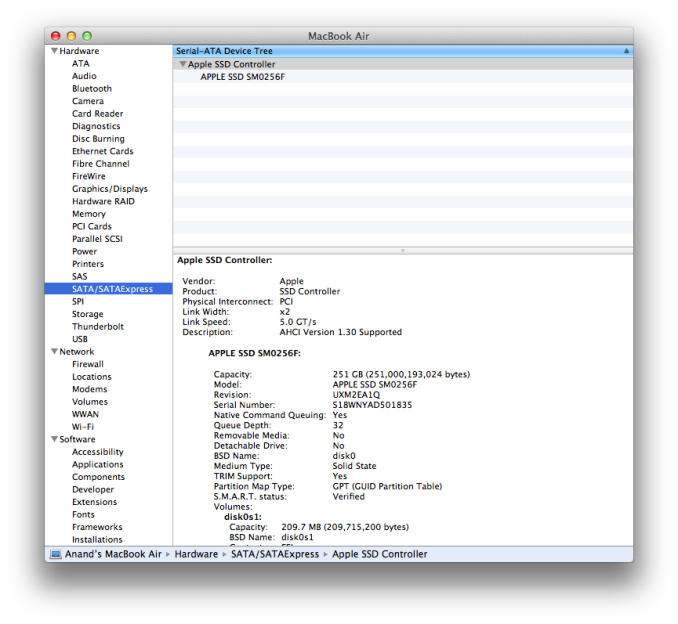

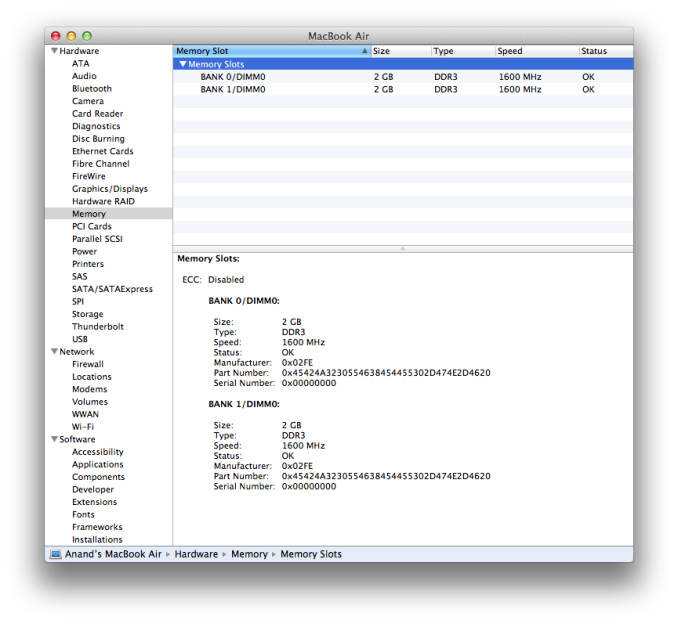








174 Comments
View All Comments
repoman27 - Wednesday, June 12, 2013 - link
I was wrong. DSL3510L, Cactus Ridge 4C. No DisplayPort 1.2 support.It seems Intel has finally added Thunderbolt controllers to ARK. Still no spec sheets, but they do list pricing. $9.95 for the Cactus/Redwood Ridge 4C controllers, $9.40 for the 2C versions (why bother?) and $5.25 for Port Ridge. That's a lot cheaper than I thought. Maybe they are charging a steep licensing fee after all.
coolhardware - Monday, June 10, 2013 - link
Nice to see a PCIe SSD show up in a consumer product :-)I wish Apple had splurged on the displays though as much of the competition,
not to mention the iPad, have higher res displays :-(
PS as an illustration, here's a handy dandy little list of the top pixel density laptops:
http://pixensity.com/list/laptop/
(site is still in beta)
easp - Monday, June 10, 2013 - link
Apple already has a HiDPI 13" laptop, the 13" retina MacBook Pro, which has been out for a while now and yet is missing from your list.The MacBook Air line puts an emphasis on being lightweight (hence the name). A Macbook Air with a retina display and an Apple-worthy battery life would basically be indistinguishable from a rMBP 13".
teknic - Tuesday, June 11, 2013 - link
You just explained apple's marketing strategy... way to go.coolhardware - Tuesday, June 11, 2013 - link
Thanks for mentioning the MBP13 easp, it has now been added to the list:http://pixensity.com/list/
Also, you can add stuff to the list yourself if you want to contribute:
http://pixensity.com/add/
Personally I think teknic is on to something there... if Apple can do high resolution on an iPad they could do it on a MBA IMHO at least as an option, that way people could choose if they wanted more battery life (and low-res) or high resolution (and some degree shorter battery life) on their MBA.
As for that making it an MBP clone, personally I prefer the MBA form factor for travel and/or actually using a laptop on my lap.
PS thanks to Anandtech readers for adding a bunch of items to the pixel density list last night, appreciate the help!
fteoath64 - Tuesday, June 11, 2013 - link
"A Macbook Air with a retina display and an Apple-worthy battery life would basically be indistinguishable from a rMBP 13".Not if the Air sports a 1600X 1200 resolution display going back to 4:3 aspect ratio which makes more sense in viewing web and documents rather than the idiotic 16:10 ratio!.
abs1992 - Tuesday, June 18, 2013 - link
what they could have done is have a macbook air with 1080p display. This would take a battery life hit of about 2 hrs (having 10 hrs of battery life compared to 12 hrs is a compromise I would be willing to make, if it meant a better screen). I get this figure by comparing other laptops battery life. toshiba kirabook lasts about 5.25 hrs with a 2560 x 1440 screen. Apple MBA (last gen) lasts for 6.25 hrs with 1440 x 800 screen. Assuming haswell doubles the battery life, (which has been proven), having a retina display MBA would result in battery life of about 10 hrs approximately. I would think its would be better since it is OSX and not windows 8.Now, some people are saying that it will be too similar to a retina MBP 13". I say the MBP 13" should add a discrete graphics card, like it does on the MBP 15" to differentiate between the two laptops.
ghm3 - Monday, June 10, 2013 - link
Just ordered an 11" w/ an i7/8GB RAM/512GB storage. This'll be my first Mac since my C2D Macbook back in 2007, can't wait to play with it!I'm looking forward to to the ample battery life for long flights I'm frequently on, My M11xR3 is good for about 3.5-4h of video w/ wifi/BT off and and the brightness down, I'm guessing this thing will be good for at least 6hr+ of nonstop video playback.
Homeles - Monday, June 10, 2013 - link
Looks like the 13" is down $100 over last year's launch prices? That price drop was greatly needed. Despite this, MacBook Airs are still the least interesting PCs that Apple sell, in my eyes.The 800 MB/s SSD is grossly overpowered for the kind of workloads that the MBA will be handling. Still, I can't help but hope that this helps drive PCI-E to be more mainstream in the SSD space, and carries over to the retail SSD market someday.
Looks like weight didn't change at all on the 13". I guess the alleged benefits of component reduction due to Haswell's FIVR aren't being realized here, or are not making a difference on the weight.
I do feel like Apple could have done so much better with Haswell, though. Every improvement being made here is going toward battery life, and the graphics boost is simply something that tags along by sheer coincidence. Could they not have made the CPU a little less anemic? Did they really have to jump all the way from their already industry leading 7 Hr battery life to 12? I guess they're trying to maintain their battery life edge, but there's a point where ludicrous battery life will have a diminishing return on your sales numbers. I suppose the jump from 7 to 12 hours is still within the range of being a useful boost, but they're pushing it.
Lower power memory, Haswell, and a higher performing SSD: all three will make no influence on the user's perception of the MacBook Air's performance. Those are almost literally the only changes coming. Perhaps 802.11 ac sneaks its way in, but at the end of the day we're just looking at everything amounting to more battery life -- something Apple already has enough of.
No redesign, still the same boring color gamut, no weight reduction, no noticeable performance boost. Just more battery life and a price cut.
How boring!
xTRICKYxx - Monday, June 10, 2013 - link
How Boring? This is the first Ultrabook with serious battery life and at an extremely competitive price point.I do think it was a mistake for Apple to skimp out on the displays sense nearly every other flagship Ultrabook will have 1080P+ displays.
Isn't it exciting to see computers finally getting all-day battery life? I mean, I remember wishing for a laptop with battery life like this in the 90's!